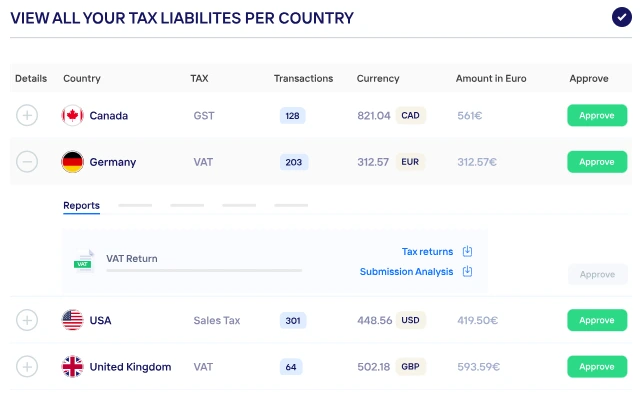Key takeaways
- Business process automation saves time, reduces human error, and frees up teams to focus on strategic growth.
- From tax compliance to social media, tools like Taxually, Xero, and HubSpot streamline operations across departments.
- Embracing automation now helps future-proof your business against regulatory changes and scaling challenges.
In today’s fast-paced business environment, relying on manual processes is no longer efficient—or sustainable. Whether it’s for tax compliance or customer support, companies that adopt business automation technology save time, reduce errors, and create scalable systems that support long-term growth.
From finance to HR, almost every department can benefit from business process automation. The key is knowing where to start.
What tasks should your business be automating?
Manual processes might have worked in the past, but they’re no match for the speed and complexity of today’s digital economy. By embracing business process automation, companies can reduce overhead, streamline workflows, and scale efficiently.
Here are the tasks every business should consider automating:
1. Invoicing and billing
Manually generating and tracking invoices is time-consuming and error-prone. Automating your billing process ensures timely invoicing, improves cash flow, and reduces admin workload. With e-invoicing becoming mandatory in more countries, automation is no longer optional—it’s essential for staying compliant with structured formats and real-time reporting requirements.
2. VAT and sales tax compliance
Given the constantly shifting tax rules across jurisdictions and the complexity of international tax laws, not automating VAT and sales tax processes simply isn’t an option anymore. Automated systems reduce audit risk, ensure timely filings, and make managing global obligations more scalable as your business grows.
3. Email marketing campaigns
Email remains one of the highest-ROI marketing channels—but managing campaigns manually is inefficient. Automation helps you segment audiences, trigger emails based on customer behavior, and maintain consistent engagement without constant oversight.
4. Customer Relationship Management (CRM)
Manual data entry into your CRM slows your sales team down. Automating tasks like lead routing, follow-ups, and status updates allows your team to focus on closing deals and building relationships instead of updating spreadsheets.
5. Inventory management
Tracking inventory manually leads to stockouts, over-ordering, and human error. Automated inventory systems ensure real-time updates, smarter restocking decisions, and better supply chain visibility—especially critical for e-commerce and retail businesses.

6. Payroll and HR onboarding
Processing payroll or onboarding new hires manually can lead to compliance issues and unhappy employees. Automating HR workflows improves accuracy, reduces admin time, and ensures a smooth onboarding experience.
7. Data backup and cybersecurity monitoring
Data loss, ransomware, and cyberattacks are growing threats. Automating backups and cybersecurity monitoring ensures your business data is protected around the clock—without relying on manual interventions.
8. Social media scheduling
Maintaining an active online presence requires consistent posting. Automating your social media scheduling keeps your content pipeline full and ensures timely posts across multiple platforms without micromanaging every post.
9. Internal approvals and requests
Leave approvals, budget signoffs, and purchase requests are often slowed down by inefficient email chains. Automating internal workflows speeds up decision-making and adds transparency to your approval processes.
10. Customer support (chatbots and helpdesks)
Manual ticket routing and response delays frustrate customers. Automating your support channels—using chatbots and helpdesk tools—ensures faster resolutions, 24/7 availability, and better customer experiences.
What are the best business automation tools?
Here are ten top business automation platforms that can help you streamline each of the tasks listed above. These tools represent some of the best in their category and can integrate easily into your existing systems.
1. Xero – Invoicing and billing
Xero is a cloud-based accounting system that automates invoicing, reminders, and payment reconciliation. It helps businesses stay on top of cash flow by automating recurring invoices and tracking outstanding payments.
- Automates: Invoice generation, late payment reminders, recurring billing
- Bonus: Integrates with bank feeds and payment gateways for real-time visibility
2. Taxually – VAT and sales tax compliance

Taxually is an all-in-one tax automation platform that helps businesses manage VAT, sales tax, and e-invoicing obligations globally. Its product suite includes CrossTax for automated VAT compliance across 50+ countries and LumaTax for U.S. sales tax automation, including exemption certificate management and real-time nexus tracking. With automated filings, threshold alerts, and digital reporting, Taxually simplifies compliance in even the most complex jurisdictions.
- Automates: VAT and sales tax filings, OSS/IOSS, registrations, real-time threshold alerts
- Bonus: Reduces manual tax admin by up to 80% while ensuring audit-ready compliance
3. ActiveCampaign – Email marketing automation
ActiveCampaign allows you to build powerful, behavior-based email sequences that react to your customers’ actions in real time. From welcome emails to abandoned cart recovery, it turns email into a scalable growth engine.
- Automates: Campaigns, segmentation, conditional logic, and drip sequences
- Bonus: Built-in CRM and SMS automation for multichannel outreach
4. HubSpot – CRM automation
HubSpot automates contact management, email follow-ups, and sales workflows. It tracks interactions across the buyer journey and automatically scores leads, assigns them to sales reps, and notifies your team at the right time.
- Automates: Lead routing, sales pipelines, contact updates, task reminders
- Bonus: Seamlessly integrates with marketing and service hubs for end-to-end automation
5. Cin7 – Inventory management
Cin7 is a cloud inventory platform that automates stock control across online stores, warehouses, and marketplaces. It helps avoid overselling or stockouts and gives real-time visibility into your inventory levels.
- Automates: Stock updates, purchase orders, and demand forecasting
- Bonus: Built-in POS and B2B e-commerce features
6. Gusto – Payroll and HR automation
Gusto automates payroll processing, tax filings, benefits administration, and onboarding tasks. It ensures accurate wage payments, handles tax calculations, and provides self-service onboarding portals for new hires.
- Automates: Salaries, tax withholdings, HR documents, benefits
- Bonus: Includes compliance alerts and digital signature collection
7. Acronis Cyber Protect – Backup and cybersecurity
Acronis combines automated cloud backups with real-time cybersecurity. It scans for malware, applies patches, and keeps your business systems secure—all with minimal manual effort.
- Automates: Backups, ransomware protection, vulnerability assessments
- Bonus: Centralized dashboard for all data protection and security tasks
8. Buffer – Social media scheduling
Buffer enables you to plan and schedule posts across platforms like LinkedIn, Instagram, and X. It also provides engagement insights and analytics to refine your strategy.
- Automates: Social content posting, queue management, analytics
- Bonus: Easy-to-use browser extension and mobile app
9. Kissflow – Internal workflow automation
Kissflow is a low-code/no-code automation tool that allows teams to digitize internal requests—like travel approvals, purchase orders, and leave applications. Everything is tracked and logged in a central dashboard.
- Automates: Approvals, task routing, custom workflows
- Bonus: Includes low-code app builder for more advanced use cases
10. Zendesk – Customer support automation
Zendesk uses AI to route tickets, trigger automated responses, and escalate issues. It supports live chat, email, phone, and social channels, all from a unified support interface.
- Automates: Ticket tagging, chatbot responses, satisfaction surveys
- Bonus: Integrates with CRMs and knowledge bases for 360° customer support
Why your business should automate processes
Adopting a business automation strategy transforms how your company operates. By shifting from manual processes to automated processes, you’ll:
- Reduce human error and compliance risk
- Lower costs and free up staff for strategic work
- Improve customer experience with faster service
- Build scalable systems that grow with your business
Automation isn’t just about efficiency—it’s about future-proofing your operations.
Book a free call with one of Taxually’s experts and discover how our tax automation solutions can simplify your VAT and sales tax compliance.
Further reading
7 Must-Have Features of Automated Tax Compliance Software
Your Guide to Electronic Invoicing EU
Everything You Need to Know About the One Stop Shop (OSS)
Everything You Need to Know About the Import One Stop Shop (IOSS)
Frequently asked questions
New Year's Day - 1/1/2024Memorial Day - 5/27/20244th of July - 7/4/2024Labor Day - 9/2/2024Thanksgiving Day - 11/28/2024Day after Thanksgiving - 11/29/2024Christmas Eve - 12/24/2024Christmas Day - 12/25/2024
What is business process automation?
Business process automation uses technology to complete repetitive tasks—like invoicing, payroll, or CRM updates—without manual input. It helps reduce errors, save time, and streamline workflows.
Which departments benefit most from automation?
Almost every department can benefit, but automation has the biggest impact in finance, tax, HR, sales, marketing, and customer support—where manual tasks are frequent and time-consuming.
Why is tax automation so important?
Tax laws are complex and change often. Tools like Taxually help businesses automate VAT and sales tax compliance, reducing audit risk and ensuring timely filings across jurisdictions.
Is automation only for large businesses?
No—small and mid-sized businesses can benefit just as much, especially with user-friendly, cloud-based tools that scale as your company grows.
What should I automate first?
Start with high-volume, repetitive tasks like invoicing, tax filing, email campaigns, or payroll. These offer quick wins in efficiency and accuracy, and can free up resources for more strategic work.


















